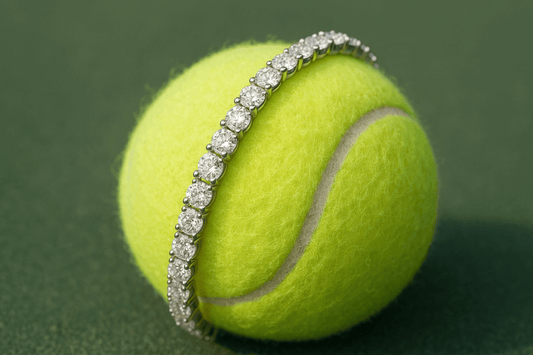
What Is 925 Sterling Silver? A Complete Guide to Silver Purities
Melissa BanShare
Introduction
Silver is one of the most popular metals in jewellery and investment, valued for its lustrous beauty, durability, and affordability. However, not all silver is the same. You may have heard terms like 925 sterling silver, pure silver (999), 958, 800, and 900 silver. But what do these numbers mean?
In this comprehensive guide, we will break down different types of silver, their composition, advantages, and how to identify genuine silver. If you're looking to buy, sell, or invest in silver jewellery, coins, or antiques, this article is for you.
What Is Silver Purity?
Silver purity refers to the percentage of actual silver content in an alloy. Since pure silver (999 silver) is very soft and malleable, it is often mixed with other metals like copper to enhance its strength and durability. This results in various grades of silver, measured by their millésimal fineness (parts per thousand).
Types of Silver Based on Purity
1. 999 Silver (Fine Silver or Pure Silver)
Composition: 99.9% silver + 0.1% trace elements
Common Uses: Bullion bars, coins, high-end jewellery
999 silver, also known as fine silver, is the purest form of silver available in the market. Since it contains 99.9% silver, it has a very bright and lustrous appearance. However, due to its softness, pure silver is not ideal for everyday jewellery as it can easily bend, scratch, or lose shape.
Pros:
-
Highest purity level
-
Ideal for investment (bullion and coins)
-
Hypoallergenic (perfect for sensitive skin)
Cons:
-
Very soft and prone to damage
-
Not ideal for rings, bracelets, or other daily wear jewellery
2. 958 Silver (Britannia Silver)
Composition: 95.8% silver + 4.2% other metals (usually copper)
Common Uses: Premium jewellery, British silverware, collectible coins
Britannia silver, introduced in 1697 in the UK, has a slightly higher silver content than sterling silver (925). The British government originally mandated Britannia silver to discourage people from melting coins for jewellery. Today, Britannia silver is highly valued in the UK and commonly found in high-end antique pieces and collectible silver items.
Pros:
-
More durable than pure silver
-
Considered a premium silver standard in the UK
-
Recognised and hallmarked by the Britannia stamp (a lady with a trident)
Cons:
-
Still softer than sterling silver
-
Less commonly available than 925 silver
3. 925 Sterling Silver (Standard Silver)
Composition: 92.5% silver + 7.5% copper or other alloys
Common Uses: Jewellery, cutlery, accessories, watches
925 sterling silver is the most popular and widely used silver alloy, especially in fine jewellery. The 92.5% silver content ensures a balance between purity and durability, while copper or other metals provide strength and resistance to scratches.
Hallmarks: Look for "925" stamped on jewellery or silverware, which guarantees its authenticity.
Pros:
-
Ideal for everyday jewellery (rings, necklaces, earrings)
-
More affordable than gold or platinum
-
Easier to maintain than pure silver
-
Tarnish-resistant (with proper care)
Cons:
-
Can tarnish over time due to exposure to air and moisture (can be cleaned easily)
-
Requires regular polishing to maintain shine
4. 900 Silver (Coin Silver)
Composition: 90% silver + 10% other metals (copper, nickel)
Common Uses: Vintage American coins, some silver jewellery
900 silver, also called coin silver, was commonly used for US coins before 1965. Some older jewellery and antique silverware may also be made from 900 silver.
Pros:
-
More durable than 925 silver
-
Common in antique and collectible pieces
Cons:
-
Lower silver content than sterling silver
-
Can tarnish and corrode over time
5. 800 Silver
Composition: 80% silver + 20% other metals (copper, zinc)
Common Uses: Vintage European silverware, antique jewellery
800 silver is most commonly found in antique European silver items, particularly from France, Italy, and Germany. It is not as lustrous as 925 silver, but it is more affordable and durable.
Pros:
-
Common in vintage and antique jewellery
-
Stronger than higher-purity silver
Cons:
-
Less valuable than sterling silver
-
Tends to tarnish faster due to lower silver content
How to Identify Real Silver
1. Look for Hallmarks
Most genuine silver jewellery and items will have a hallmark indicating their purity, such as:
-
999 (Pure Silver)
-
958 (Britannia Silver)
-
925 (Sterling Silver)
-
900 (Coin Silver)
-
800 (European Silver)
2. Magnet Test
Silver is non-magnetic. If your silver item sticks to a magnet, it may contain other metals or be silver-plated.
3. Acid Test
A small drop of nitric acid on real silver will turn it milky white. However, this test should only be done by professionals.
4. Tarnishing Test
Real silver oxidises and tarnishes over time, turning black. Fake silver or silver-plated items do not tarnish the same way.
How to Care for Silver Jewellery
To maintain the shine and longevity of silver jewellery:
-
Store in an anti-tarnish pouch to prevent oxidation.
-
Clean with a silver polishing cloth to remove tarnish.
-
Avoid exposure to chemicals, such as perfume, chlorine, or harsh cleaning agents.
-
Wear your silver jewellery often – the natural oils from your skin help prevent tarnish!
Conclusion
Understanding silver purity is essential when purchasing jewellery, investing in silver, or collecting antiques. Whether you're looking for fine silver (999), sterling silver (925), Britannia silver (958), or antique silver (800/900), each type has its own benefits and uses.
For those who love affordable yet high-quality jewellery, 925 sterling silver is the best option. If you're investing in silver bullion, 999 silver is the purest choice. Knowing the differences will help you make informed decisions when buying or selling silver.
Ready to buy high-quality silver jewellery?
Explore our collection of 925 sterling silver jewellery and find the perfect piece for you!



